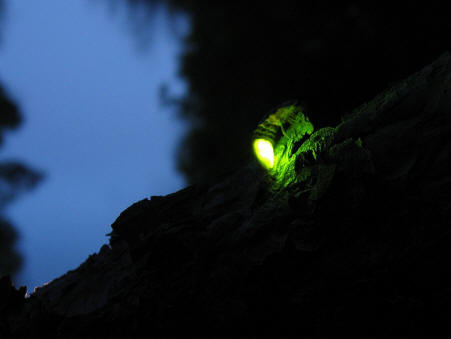Form & Function
Photinus ignitus can either fly or crawl. It is an
arthropod so the legs are jointed appendages, which allows
movement in one direction. The part that makes fireflies
so unique and helps them to stand out among other organisms is
their bioluminescenct abdomen.
There is curiosity in how Photinus ignitus obtained its
bioluminescence ability. One idea is that it came from
their common ancestor, the cantharoid beetle (Lewis & Cratsley,
2008). The cantharoid beetle also displays
bioluminescence, which Photinus ignitus may have inherited.
The bioluminescence trait began in firefly larvae as a warning
to potential predators in the area. It then evolved in the
form of courtship in adult fireflies. This type of shift
in trait function is called exaptation.

Photinus ignitus produce their bioluminescence light by a
two step reaction that is sped up by the enzyme luciferase.
This process takes place in the light producing organs called
lanterns. The light producing organs are emitting light in
all stages of development of the firefly. The eggs,
larvae, and pupae produce glows that are modulated, but when
they are adults they control their bioluminescence to find mates
(Lewis & Cratsley, 2008). Courtship is based on an
evolutionary process. Females look at male signals to
determine if they will provide a greater nutritional
contribution at mating, which you can read more about in our
reproduction page Male courtship signals are used to
determine which male will give more a nutritional gift.
The signals can also determine if the offspring will have
desirable phenotypes. The females determine all this by
simply looking at the male light signals (Cratsley, 2004).
Photinus ignitus has developed a defensive trait by making
lucibufagins, a defensive steroid (Eisner et. al., 1978).
When predators eat fireflies the lucibufagins are also ingested,
which gives the predator a bitter taste and can be lethal to
them if too much is ingested. Thus, the next time the
predator spots a firefly, they will not be tempted to eat it
since last time it left a bitter taste in their mouth. The
most accepted conclusion of how fireflies obtained this trait
was from a common ancestor, which produced lucibufagins from
ingested cholesterol.

Photinus ignitus females used to emit pheromonal signals to
attract males, but they evolved to use visual signals. The
advantages of using pheromonal signals is that females do not
give there position away to predators, but a disadvantage is
that it takes males a longer time to locate a female. With
males taking a longer time to find their mate, it gives
predators a longer chance to eat the males. The advantage
of using visual signals is that it is easier to find each other;
however, a disadvantage is that it is more identifiable in an
open field where predators can seek the firefly more easily
(Lewis & Cratsley, 2008).
Back to
Home
Read about
Reproduction
